Lincoln Navigator: Supplemental Restraint System / Pyrotechnic Device Disposal. General Procedures
Disposal
Disposal of Deployable Devices and Pyrotechnic Devices That Are Undeployed-Inoperative
NOTE: All inoperative airbags, seatbelt pretensioners and inflatable seatbelt inflators have been placed on the Mandatory Return List. Treat all discolored or damaged airbags the same as any inoperative live airbag being returned.
-
 WARNING:
Before beginning any service procedure in this
manual, refer to health and safety warnings in section 100-00 General
Information. Failure to follow this instruction may result in serious
personal injury.
WARNING:
Before beginning any service procedure in this
manual, refer to health and safety warnings in section 100-00 General
Information. Failure to follow this instruction may result in serious
personal injury.
-
Depower the SRS
Refer to: Supplemental Restraint System (SRS) Depowering (501-20B Supplemental Restraint System, General Procedures).
-
Remove the undeployed/inoperative device. Refer to
the appropriate procedure in this section or in the seatbelt system
section.
-
NOTE: When installing a new airbag or inflatable seatbelt inflator, a prepaid return postcard is provided with the replacement part. The serial number for the new part and the VIN must be recorded and sent to Ford Motor Company.
If installing a new airbag, or inflatable seatbelt inflator, record the necessary information and return the inoperative airbag to Ford Motor Company.
Disposal of Deployable Devices and Pyrotechnic Devices That Are Deployed
-
Depower the SRS .
Refer to: Supplemental Restraint System (SRS) Depowering (501-20B Supplemental Restraint System, General Procedures).
-
Remove the deployed device. Refer to the appropriate
procedure in this section or in the seatbelt system section.
-
NOTE: If a dual stage driver or passenger airbag has deployed due to a crash event, the airbag requires manual deployment to make sure both stages and the active canister vent (if equipped) have deployed before scrapping the vehicle or disposing of the airbag.
Determine if the vehicle is equipped with dual stage driver or passenger airbags.
Refer to: Airbag and Seatbelt Pretensioner Supplemental Restraint System (SRS) - Component Location (501-20B Supplemental Restraint System, Description and Operation).
-
REFER to: Disposal of Deployable Devices and
Pyrotechnic Devices That Require Manual Deployment in this procedure.
-
Seal the deployed air bag module(s) in the packaging
from the new air bag module(s) or a suitable polythene bag and dispose
of the deployed device.
-
If required, dispose of in accordance with local contaminated waste regulations.
-
If there are no local contaminated waste
regulations, dispose of the deployed device in the same manner as any
other part to be scrapped.
-
If required, dispose of in accordance with local contaminated waste regulations.
Disposal of Deployable Devices and Pyrotechnic Devices That Require Manual Deployment
NOTE: Safety and environmental concerns require consideration and treatment of restraints system deployable and pyrotechnic devices when disposing of vehicles, deployable devices or pyrotechnic devices. Deploying deployable and pyrotechnic devices before scrapping a vehicle or the device eliminates the potential for hazardous exposures or reactions during processing. If special handling procedures are followed, deployable and pyrotechnic devices can be deployed safely and recycled with the vehicle, shipped separately to a recycling facility or disposed of safely.
-
To determine the deployable devices a vehicle is equipped with:
Refer to: Airbag and Seatbelt Pretensioner Supplemental Restraint System (SRS) - Component Location (501-20B Supplemental Restraint System, Description and Operation).
-
A vehicle equipped with any of the following
deployable devices requires manual deployment of the devices before
scrapping the vehicle or component. For additional information, refer to
the appropriate portion of this procedure.
-
-
Driver airbag
-
Inflatable seatbelt inflators
-
Knee airbag
-
Passenger airbag
-
Seat side airbag
-
Safety Canopy®
-
Side air curtain
-
Driver airbag
-
To determine the pyrotechnic devices a vehicle is equipped with:
Refer to: Airbag and Seatbelt Pretensioner Supplemental Restraint System (SRS) - Component Location (501-20B Supplemental Restraint System, Description and Operation).
-
A vehicle equipped with any of the following
pyrotechnic devices requires manual deployment of the devices before
scrapping the vehicle or component. For additional information, refer to
the appropriate portion of this procedure.
-
-
Inflatable seatbelt inflators
-
Seatbelt buckle pretensioners
-
Seatbelt retractor pretensioners
-
Seatbelt anchor pretensioners
-
Adaptive load-limiting retractors
-
Deployable steering column
-
Inflatable seatbelt inflators
-
NOTE: If a dual stage driver or passenger airbag has deployed due to a crash event, the airbag requires manual deployment to make sure both stages and the active canister vent (if equipped) have deployed before scrapping the vehicle or disposing of the airbag.
To determine if a vehicle is equipped with dual stage driver or passenger airbags:
Refer to: Airbag and Seatbelt Pretensioner Supplemental Restraint System (SRS) - Component Location (501-20B Supplemental Restraint System, Description and Operation).
-
If a dual stage driver or passenger airbag has
deployed due to a crash event, the airbag requires manual deployment to
make sure both stages and the active canister vent have deployed before
scrapping the vehicle or disposing of the airbag. Refer to Driver,
Passenger, Knee, Side Curtain and Seat Side Airbags - Remote Deployment
in this procedure.
Driver, Passenger, Knee, Side Curtain and Seat Side Airbags - Remote Deployment
NOTE: For airbags with multiple loops, deploy all of the loops on the airbag.
NOTE: Some driver and passenger front airbags have 2 deployment stages and an active canister vent. After a collision it is possible that Stage 1 has deployed and Stage 2 and the active canister vent have not. If a front airbag has deployed, it is mandatory the front airbag be remotely deployed using the appropriate airbag disposal procedure.
NOTE: A typical airbag disposal is shown that is similar for all vehicles.
-
-
NOTE: The tires must be of sufficient size to accommodate the airbag.
Obtain a tire and wheel assembly and 4 additional tires (without wheels) of the same size.
-
With the tire and wheel assembly on the bottom, stack the tires.
-
Securely tie all of the tires together.
-
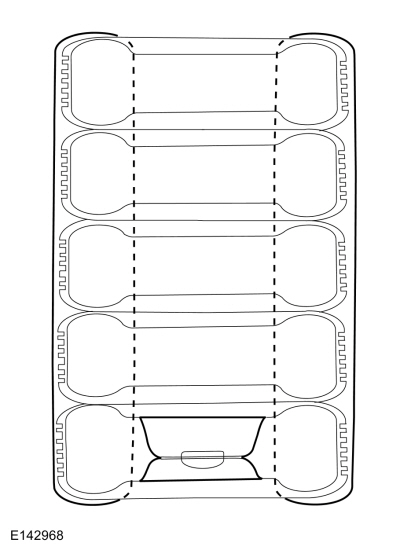 |
-
Depower the SRS
Refer to: Supplemental Restraint System (SRS) Depowering (501-20B Supplemental Restraint System, General Procedures).
-
Remove the airbag. Refer to the appropriate procedure in this section.
-
If the airbag does not have a hard-wired pigtail:
-
For vehicles being scrapped, cut each of the
airbag wires near the electrical connector that connects to the vehicle
wire harness.
-
For vehicles not being scrapped, acquire the
appropriate wiring pigtail kit. REFER to the Wiring Diagrams manual.
-
For vehicles being scrapped, cut each of the
airbag wires near the electrical connector that connects to the vehicle
wire harness.
-
Remove any sheathing (if present) and strip the insulation from the ends of the cut wires.
-
NOTE: Typical driver airbag with 2 loops shown, other airbags with multiple loops or multiple features (canister vent, active tether) similar.
For airbags with multiple loops, twist together a wire from each loop then repeat for the remaining wires from each loop.
 |
-
-
Make a jumper harness to deploy the airbag
module by obtaining 2 wires (20 gauge minimum) at least 9.14 m (30 ft).
-
At one end of the jumper harness, connect the wires together.
-
Make a jumper harness to deploy the airbag
module by obtaining 2 wires (20 gauge minimum) at least 9.14 m (30 ft).
-
Using the end of the jumper harness where the wires
are not connected together, attach each wire of the jumper harness to
each wire of the airbag or to the twisted-together wires if multiple
loops. Use tape or other insulating material to make sure the leads do
not make contact with each other.
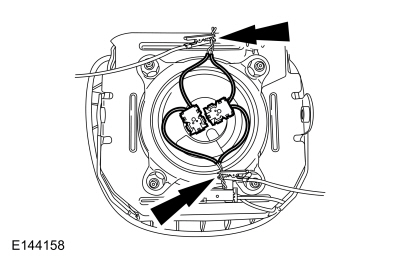 |
-
NOTE: Make sure the airbag connections are maintained.
For driver airbags, with the stack of tires upright and the wheel on the bottom, carefully place the driver airbag, with the trim cover facing up, on the wheel.
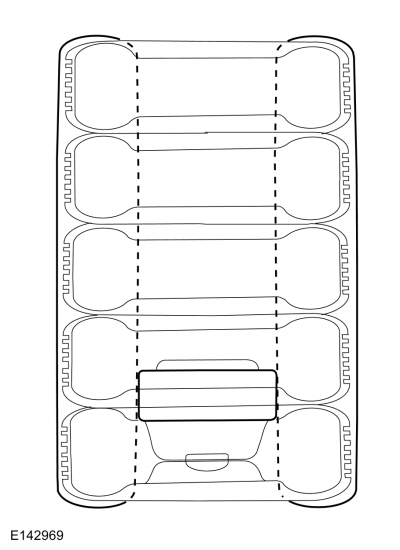 |
-
NOTE: Make sure the airbag connections are maintained.
-
For passenger, knee and seat side airbags, tip the stack of tires on its side.
-
Place the airbag inside the center tire, making
sure that there are 2 tires beneath the tire containing the airbag and 2
tires (including the tire and wheel assembly) above the tire containing
the airbag.
-
Place the tire stack upright, with the wheel on top.
-
For passenger, knee and seat side airbags, tip the stack of tires on its side.
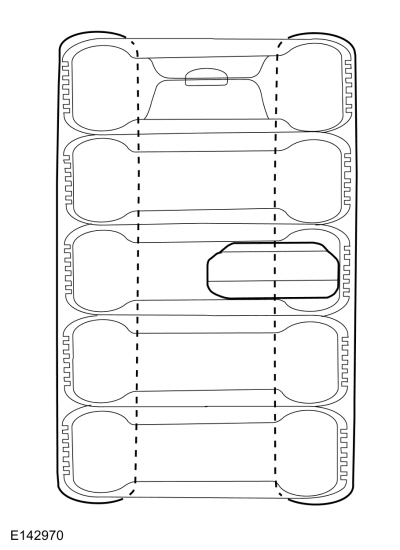 |
-
Remain at least 9.14 m (30 ft) away from the airbag.
-
From the end of the jumper harness that is not
connected to the airbag, disconnect the 2 wires of the jumper harness
from each other.
-
Deploy the airbag by touching the ends of the 2
wires of the jumper harness to the terminals of a 12-volt battery.
-
To allow for cooling, wait at least 10 minutes before approaching the deployed airbag.
-
Dispose of the deployed airbag in the same manner as any other part to be scrapped.
Seatbelt Anchor-Buckle-Retractor Pretensioners, Adaptive Load Limiting Retractors and Seatbelt Inflators - Remote Deployment
-
-
NOTE: The tires must be of sufficient size to accommodate the seatbelt anchor, buckle, retractor or inflator.
Obtain a tire and wheel assembly and 4 additional tires (without wheels) of the same size.
-
With the tire and wheel assembly on the bottom, stack the tires.
-
Securely tie all of the tires together.
-
 |
-
Depower the SRS .
Refer to: Supplemental Restraint System (SRS) Depowering (501-20B Supplemental Restraint System, General Procedures).
-
Remove the seatbelt anchor, buckle, retractor or
inflator. Refer to the appropriate procedure in the seatbelt system
section.
-
If the seatbelt anchor, buckle, retractor or
inflator does not have a hard-wired pigtail, cut each of the wires near
the electrical connector that connects to the vehicle wire harness.
-
When deploying a seatbelt buckle pretensioner,
install a nut and bolt of sufficient length and the same diameter used
to retain it to the seat.
-
Remove any sheathing (if present) and strip the insulation from the ends of the cut wires.
-
-
Make a jumper harness to deploy the seatbelt
anchor, buckle, retractor or inflator by obtaining 2 wires (20 gauge
minimum) at least 9.14 m (30 ft).
-
At one end of the jumper harness, connect the wires together.
-
Make a jumper harness to deploy the seatbelt
anchor, buckle, retractor or inflator by obtaining 2 wires (20 gauge
minimum) at least 9.14 m (30 ft).
-
NOTE: Typical seatbelt retractor pretensioner shown, other seatbelt anchor pretensioners, buckle pretensioners, load-limiting retractors and seatbelt inflators similar.
Using the end of the jumper harness where the wires are not connected together, attach each wire of the jumper harness to each wire of the seatbelt anchor, buckle, retractor or inflator. Use tape or other insulating material to make sure the leads do not make contact with each other.
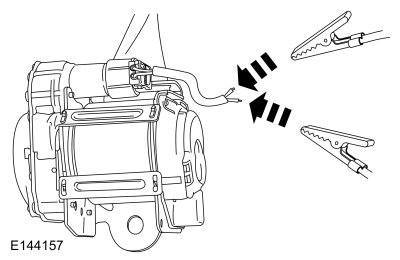 |
-
NOTE: Make sure the airbag connections are maintained.
-
Tip the stack of tires on its side.
-
Place the seatbelt anchor, buckle, retractor or
inflator inside the center tire, making sure that there are 2 tires
beneath the tire containing the airbag and 2 tires (including the tire
and wheel assembly) above the tire containing the airbag.
-
Place the tire stack upright, with the wheel on top.
-
Tip the stack of tires on its side.
 |
-
Remain at least 9.14 m (30 ft) away from the seatbelt anchor, buckle, retractor or inflator.
-
From the end of the jumper harness that is not
connected to the seatbelt anchor, buckle, retractor or inflator,
disconnect the 2 wires of the jumper harness from each other.
-
Deploy the seatbelt anchor, buckle, retractor or
inflator by touching the ends of the 2 wires of the jumper harness to
the terminals of a 12-volt battery.
-
To allow for cooling, wait at least 10 minutes
before approaching the deployed seatbelt anchor, buckle, retractor or
inflator.
-
Dispose of the deployed seatbelt anchor, buckle,
retractor or inflator in the same manner as any other part to be
scrapped.
Seatbelt Anchor-Buckle-Retractor Pretensioners, and Adaptive Load Limiting Retractors - In-Vehicle Deployment
-
Depower the SRS
Refer to: Supplemental Restraint System (SRS) Depowering (501-20B Supplemental Restraint System, General Procedures).
-
Access the seatbelt anchor, buckle or retractor
electrical connectors. Refer to the appropriate procedure in the
seatbelt system section.
-
Cut each of the seatbelt anchor, buckle or retractor wires, leaving at least 101.6 mm (4 in) to work with.
-
Remove any sheathing (if present) and strip the insulation from the ends of the cut wires.
-
-
Make a jumper harness to deploy the seatbelt
anchor, buckle or retractor by obtaining 2 wires (20 gauge minimum) at
least 9.14 m (30 ft).
-
At one end of the jumper harness, connect the wires together.
-
Make a jumper harness to deploy the seatbelt
anchor, buckle or retractor by obtaining 2 wires (20 gauge minimum) at
least 9.14 m (30 ft).
-
NOTE: Typical seatbelt retractor pretensioner shown, other seatbelt anchor pretensioners, buckle pretensioners and load-limiting retractors are similar.
Using the end of the jumper harness where the wires are not connected together, attach each wire of the jumper harness to each wire of the seatbelt anchor, buckle or retractor. Use tape or other insulating material to make sure the leads do not make contact with each other.
 |
-
Remain at least 9.14 m (30 ft) away from the seatbelt anchor, buckle or retractor.
-
Remain at least 9.14 m (30 ft) away from the seatbelt anchor, buckle, retractor or inflator.
-
From the end of the jumper harness that is not
connected to the seatbelt anchor, buckle or retractor, disconnect the 2
wires of the jumper harness from each other.
-
Deploy the seatbelt anchor, buckle or retractor by
touching the ends of the 2 wires of the jumper harness to the terminals
of a 12-volt battery.
-
To allow for cooling, wait at least 10 minutes
before approaching the deployed seatbelt anchor, buckle or retractor.
-
Dispose of the deployed seatbelt anchor, buckle or
retractor in the same manner as any other part to be scrapped.
Safety Canopy® and Side Air Curtains - In-Vehicle Deployment
NOTE: The Safety Canopy® deployment for a scrapped vehicle occurs in its installed position in the vehicle.
NOTE: A typical Safety Canopy® disposal is shown.
-
Depower the SRS
Refer to: Supplemental Restraint System (SRS) Depowering (501-20B Supplemental Restraint System, General Procedures).
-
Access the Safety Canopy® /side air curtain
electrical connectors. For additional information, refer to the
appropriate procedure in this section.
-
Cut each of the Safety Canopy® /side air curtain wires, leaving at least 101.6 mm (4 in).
-
Remove any sheathing (if present) and strip the insulation from the ends of the cut wires.
-
NOTE: Typical Safety Canopy® /side air curtain with 2 loops shown, other Safety Canopy® /side air curtains with 2 loops are similar.
For Safety Canopy® /side air curtains with multiple loops, twist together a wire from each loop then repeat for the remaining wires from each loop.
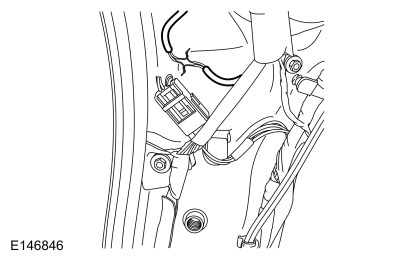 |
-
-
Make a jumper harness to deploy the Safety
Canopy®/side air curtains by obtaining 2 wires (20 gauge minimum) at
least 9.14 m (30 ft).
-
At one end of the jumper harness, connect the wires together.
-
Make a jumper harness to deploy the Safety
Canopy®/side air curtains by obtaining 2 wires (20 gauge minimum) at
least 9.14 m (30 ft).
-
Using the end of the jumper harness where the wires
are not connected together, attach each wire of the jumper harness to
each wire of the Safety Canopy® /side air curtain or to the
twisted-together wires if multiple loops. Use tape or other insulating
material to make sure the leads do not make contact with each other.
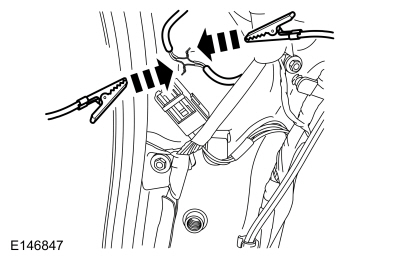 |
-
From the end of the jumper harness that is not
connected to the Safety Canopy® /side air curtain, disconnect the 2
wires of the jumper harness from each other.
-
Deploy the Safety Canopy® /side air curtain by
touching the ends of the 2 wires of the jumper harness to the terminals
of a 12-volt battery.
-
To allow for cooling, wait at least 10 minutes
before approaching the deployed Safety Canopy® /side air curtain.
-
Dispose of the deployed Safety Canopy® /side air
curtain in the same manner as any other part to be scrapped.
Deployable Steering Column - In-Vehicle Deployment
-
Depower the SRS
Refer to: Supplemental Restraint System (SRS) Depowering (501-20B Supplemental Restraint System, General Procedures).
-
NOTE: It may be necessary to lower or remove the deployable steering column from the instrument panel to access the deployable steering column electrical connector.
Access the deployable steering column electrical connector.
-
NOTE: If the deployable steering column does not have a hard-wired pigtail, cut the wires and connector(s) from the vehicle wire harness and reconnect to the deployable steering column.
Cut each of the deployable steering column wires, leaving at least 101.6 mm (4 in) to work with.
-
Remove any sheathing (if present) and strip the insulation from the ends of the cut wires.
-
-
Make a jumper harness to deploy the deployable
steering column by obtaining 2 wires (20 gauge minimum) at least 9.14 m
(30 ft).
-
At one end of the jumper harness, connect the wires together.
-
Make a jumper harness to deploy the deployable
steering column by obtaining 2 wires (20 gauge minimum) at least 9.14 m
(30 ft).
-
Using the end of the jumper harness where the wires
are not connected together, attach each wire of the jumper harness to
each wire of the deployable steering column. Use tape or other
insulating material to make sure the leads do not make contact with each
other.
 |
-
Remain at least 9.14 m (30 ft) away from the deployable steering column.
-
From the end of the jumper harness that is not
connected to the deployable steering column, disconnect the 2 wires of
the jumper harness from each other.
-
Deploy the deployable steering column by touching
the ends of the 2 wires of the jumper harness to the terminals of a
12-volt battery.
-
To allow for cooling, wait at least 10 minutes before approaching the deployed steering column.
-
Dispose of the deployed steering column in the same manner as any other part to be scrapped.
 Inspection and Repair after a Supplemental Restraint System (SRS) Deployment. General Procedures
Inspection and Repair after a Supplemental Restraint System (SRS) Deployment. General Procedures
Inspection
WARNING:
If a vehicle has been in a crash, inspect the Restraints
Control Module (RCM) and impact sensor mounting areas for any damage or
deformation...
 Supplemental Restraint System (SRS) Depowering. General Procedures
Supplemental Restraint System (SRS) Depowering. General Procedures
Depower
WARNING:
Incorrect repair techniques or actions can cause an
accidental Supplemental Restraint System (SRS) deployment. Never
compromise or depart from these instructions...
Other information:
Lincoln Navigator 2018-2025 Workshop Manual: Shift Solenoids (SS). Removal and Installation
Materials Name Specification Motorcraft® MERCON® ULV Automatic Transmission FluidXT-12-QULV WSS-M2C949-A, MERCON® ULV Removal NOTE: If a new SS is installed, carry out the adaptive learning drive cycle procedure at the end of the repair...
Lincoln Navigator 2018-2025 Workshop Manual: Steering Column Control Module (SCCM). Removal and Installation
Removal NOTE: Removal steps in this procedure may contain installation details. NOTE: This step is only necessary when installing a new component. NOTE: The PMI process must begin with the current SCCM installed. If the current SCCM does not respond to the diagnostic scan tool, the tool may prompt for As-Built data as part of the repair...
Categories
- Manuals Home
- 4th Gen Lincoln Navigator Service Manual (2018 - 2025)
- Identification Codes. Description and Operation
- Service Information
- All Terrain Control Module (ATCM). Removal and Installation
- Satellite Radio Antenna. Removal and Installation
- Head Up Display (HUD) Module Calibration. General Procedures
Front Driveshaft. Removal and Installation
Special Tool(s) / General Equipment
Crimping ToolMaterials
Name Specification Motorcraft® Premium Long-Life GreaseXG-1-E1 ESA-M1C75-B
Removal
With the vehicle in NEUTRAL, position the vehicle on a hoist.Refer to: Jacking and Lifting (100-02 Jacking and Lifting, Description and Operation).
Remove the bolts and the transmission shield.
